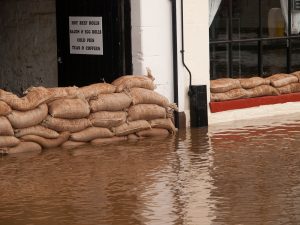洪水防止堤は、洪水を管理し、構造物を保護するために不可欠なツールである。ここでは、さまざまなタイプの洪水防止堤を効果的に使用する方法について、包括的なガイドを提供する:
洪水バリアの種類
サンドバッグ
説明麻布やポリプロピレンに砂を詰めた伝統的なバリア。重量と安定性があり、様々な地形に柔軟に対応する。
メリット
- 費用対効果
- フレキシブル
- 積み重ねが容易
- 建物やインフラの一時的な保護に適している
デメリット
- 手作業による充填と多大な労力を要する
- 完全な水密性は得られない
インフレータブル洪水バリア
説明耐久性のあるゴムや合成素材から作られたこれらのバリアは、空気を利用して防護壁を作ります。
メリット
- 軽量
- コンパクト
- 迅速な展開が容易
- 緊急事態に最適
デメリット
- より高価
- 信頼性の高いインフレーション装置が必要
- 効果は耐久性次第
ポリエチレン製洪水バリア
説明高密度ポリエチレン製で、材料を充填することも、自己膨張させることもできる。
メリット
- 耐久性
- 水や天候に強い
- 土嚢に比べて腐りにくい
デメリット
- 割高になることもある
- 専門家によるセットアップが必要な場合がある
- サンドバッグより柔軟性に欠ける
自己拡張型洪水バリア
説明水にさらされると自動的に拡張し、追加のツールなしでバリアを形成する。
メリット
- 迅速な展開
- 簡単なセットアップ
- 緊急事態に最適
デメリット
- 一旦広げると、調節や移動が難しい。
- 高さと長さに制限がある
複合洪水バリア
説明繊維、プラスチック、ゴムなどの素材をミックスし、強度と耐久性を強化。
メリット
- 優れた保護性能
- 過酷な条件への耐性
デメリット
- より高いコスト
- より複雑な設置
- 他のタイプに比べて適応性が低い
環境に優しい洪水バリア
説明生分解性素材またはリサイクル素材を使用。
メリット
- 環境への責任
- 汚染を減らす
デメリット
- 従来の素材の性能には及ばないかもしれない
- 割高になることもある
モジュール式洪水バリア
説明長さと高さを調節できる連結モジュール。
メリット
- 高い柔軟性
- 様々な洪水シナリオへの適応性
デメリット
- 高いイニシャルコスト
- 複雑な設置
適切な洪水バリアの選択
- 土嚢:手頃な価格、汎用性、一時的な洪水防御に最適。住宅地、商業施設、建設現場などでよく使用される。
- 自己拡張型洪水バリア:緊急時に迅速な展開が可能。自動的に拡張してバリアを形成するため、緊急事態に適しています。
土嚢を埋める:ステップ・バイ・ステップ
- 準備:砂が乾いている場合は、手袋、つま先のある靴、安全眼鏡を使用する。
- 砂を入れる:一人が袋を持ち、もう一人がシャベルで砂を入れる。袋の上部を折って襟を作る。
- 容量:袋の半分から3分の2まで入れると扱いやすい。
- 積み重ねる:積み重ねるときは、袋をほどいたままにしてください。密封性を高めるため、上部のフラップを折りたたむ。持ち運ぶ場合のみ結んでください。
自己拡張型洪水バリアの使用
- 起動:バリアーを水にさらされる場所に置く。自動的に膨張します。
- 配置:端から端まで配置し、連続的なバリアを形成する。
- 調整:アライメントをチェックし、バリアが固まる前に調整する。
- モニタリング:洪水時にバリアを定期的に点検し、有効性を確認する。
洪水防止壁の作り方
- 敷地の準備:ゴミを取り除き、地面が平らになるようにする。
- サンドバッグの配置土嚢袋を縦に並べ、開いている方の端を土嚢袋の下に折り込む。水の流れと平行に置く。
- 圧縮と整列各列を足で平らにし、レンガ積み状に袋を並べ、各袋を半分ずつ重ねる。
- 壁の構造:4列以上の壁の場合は、ピラミッド型に作る。濡れた」面をビニールシートで覆い、土嚢袋で固定する。
GELSAPの自己拡張型洪水バリアであなたの財産を守る

洪水防御に関しては、スピードと効果が重要です。GELSAPは、比類のない利便性と優れた洪水防御を提供するように設計された最先端の自己拡張型洪水バリアを提供しています。私たちのバリアは、卓越した吸水能力で設計されており、従来の土嚢の効果に匹敵する素晴らしい高さまで膨張します。
なぜGELSAPの自己拡張型洪水バリアを選ぶのか?
- 迅速な展開:バリアは必要な場所に設置するだけで、水と接触すると自動的に膨張し、強固で迅速な防御ラインを形成します。
- 卓越した吸収力:当社の高度な素材は、高い吸水性を確保し、効果的に洪水を制御し、方向を変えます。
- 印象的な拡張性:土嚢に匹敵するバリア高さを達成し、最小限のセットアップ時間で包括的な保護を提供します。
- 便利で効率的:軽量・コンパクトで保管や輸送が容易な当社のバリアは、緊急対応にも長期的な洪水管理にも理想的です。
GELSAPの信頼性が高く効率的な自己拡張型洪水バリアで、お客様の財産を確実に保護します。お客様が最も必要とされる時に、高品質の洪水防御を提供するために当社を信頼してください。

